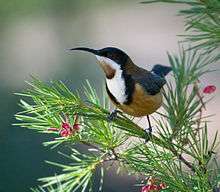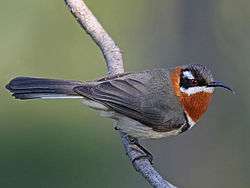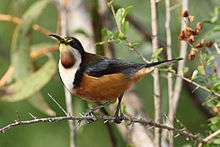Spinebill
| Spinebill | |
|---|---|
 | |
| Eastern spinebill | |
| Scientific classification | |
| Kingdom: | Animalia |
| Phylum: | Chordata |
| Class: | Aves |
| Order: | Passeriformes |
| Family: | Meliphagidae |
| Genus: | Acanthorhynchus Gould, 1837[1] |
| Species | |
Spinebill is the name given to two members of the honeyeater family, both in the genus Acanthorhynchus, which is Latin for "spine bill". They are around 15 centimetres in length, and are coloured black, white and chestnut, with a long, downcurved bill. They are native to Australia, with one species in the east and one in the west. They feed on nectar as well as insects, and live mainly in forests, gardens, and other shrubbery habitats.
A 2004 molecular study has shown that the two spinebills are a sister grouping to all other honeyeaters, that is, they diverged earlier than all other species.[2]
Species
| Image | Scientific name | Common Name | Distribution |
|---|---|---|---|
 | Acanthorhynchus superciliosus | Western spinebill | south-western Australia |
 | Acanthorhynchus tenuirostris | Eastern spinebill | North Queensland south through New South Wales, eastern South Australia as well as throughout Tasmania |
References
- ↑ Gould, J. (1837). "Characteristics of New Species of Australian Birds". Proceedings of the Zoological Society of London. 6: 24–25.
- ↑ Driskell, Amy C.; Christidis, Les (2004). "Phylogeny and evolution of the Australo-Papuan honeyeaters (Passeriformes, Meliphagidae)" (PDF). Molecular Phylogenetics and Evolution. 31 (3): 943–60. doi:10.1016/j.ympev.2003.10.017. PMID 15120392. Archived from the original (PDF) on 2012-05-01.
External links
- Basic information, eastern spinebill - Birds in Backyards
- Photos, eastern spinebill - Australian Birds Image Database
This article is issued from
Wikipedia.
The text is licensed under Creative Commons - Attribution - Sharealike.
Additional terms may apply for the media files.